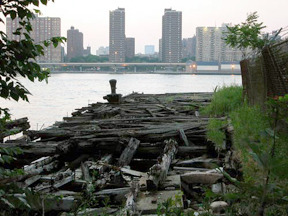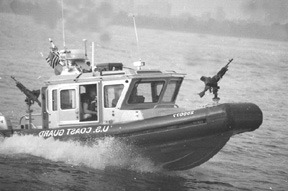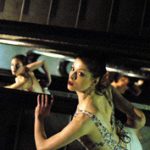Photographers: Let the Shutters Fly
Photographers of New York’s urban architecture and public transportation: beware! Police and security officers have been monitoring the photography of bridges and tunnels, subways and buses, and occasionally questioning photographers thoroughly. Is this treatment legal, and what are an artist’s rights in such a situation?
This summer, after New York City’s Metropolitan Transit Authority (MTA) announced it was contemplating a ban on photography in the subways, a group of 100 daredevil photographers rode the rails and let the shutters fly in protest. Other photographers in the New York area have unwittingly been conducting another kind of rebellion, simply by going out into the city streets and taking photos. New York Police Department (NYPD) and MTA officers, as well as private security guards, have been catching photographers in the act and asking them to cease, desist, and in some cases, show identification.
Irma Bohorquez-Geisler was working on a commission from the Staten Island Arts and Sciences Museum last spring, documenting neo-classical architecture in the area. She arrived at the courthouse on Castleton and Beamon Avenues and began taking pictures with her Nikon 5100 near the building. Four policemen came out of the court and asked her what she was doing and whether she had a permit. “I said, ‘I’m doing this work for the museum,’ but they said, ‘You have to come with us.’” They continued to ask for identification, finally relenting after she showed them some of her work. It’s difficult for Bohorquez-Geisler to tell her story without stopping to collect herself. “I’m Mexican,” she says, explaining why re-telling the story upsets her. “And I look foreign.”
Esteban Chavez (2004). Photo of a Coast Guard boat taken from Staten Island Ferry. Courtesy the artist.
Esteban Chavez, a Long Island-based photographer with a studio in Staten Island, was stopped on August 30 from taking photos on the Staten Island ferry. He had been intrigued by a nearby Coast Guard boat with machine guns. Four officers on the ferry—he suspects Coast Guard, but they didn’t identify themselves—approached him. Chavez says, “They asked, ‘Why are you photographing the Coast Guard boat? You were noticed photographing the terminal.’ One guy said, ‘Give me your ID and let me know if you’re wanted for anything, because if you are, you’re in trouble.’” Visions of jail flitted through his mind. When they docked, the officers took Chavez to meet the waiting New York City police officers. They checked his license and told him he was clear. The Coast Guard officer then went over things with Chavez: “He said, ‘You can’t photograph police terminals or Coast Guard—just tourist things. You’re in the system now.’” Rattled, Chavez didn’t ask at the time: which system? Neither Chavez nor Bohorquez-Geisler has since gone back to take photos by the ferry or the courthouse.
The subway ban never went into law, and no law forbids photographing ferries and courthouses. On September 17, 2004, the MTA updated its rules of conduct to stipulate that photography, filming, or video recording is permitted, as long as lights, reflectors, and tripods aren’t used and transportation service isn’t impeded in the process. Both the New York Daily News and Volunteer Lawyers for the Arts report, however, that police officers were instructed to act as if the ban had been in effect this summer.
Detective Walter Burnes at the NYPD’s office of the Deputy Commissioner for Public Information, says, “Anybody can take photos anytime. People are free in this country to do those sort of things, unless what you’re doing creates some kind of hazard.” Many people say they’ve never had a problem snapping photos of public infrastructure, but it doesn’t take much to find others who have. “It’s an issue that we’ve been getting more calls about since around May,“ says Jeffrey Klein, an attorney at Volunteer Lawyers for the Arts. Determination of hazard is left to the discretion of the police officer. As Detective Burnes put it, “Stopping and asking somebody for information about a situation depends on the situation.”

Mike Epstein (2004). Photo of Manhattan Bridge. Courtesy the artist.
Mike Epstein, a programmer and photographer who regularly posts images to his photo blog, www.satanslaundromat.com, says he’s been stopped three times by the NYPD in the past couple years. On one occasion, in the Brooklyn neighborhood of DUMBO in 2003, he was on a deserted street taking pictures near the Manhattan Bridge. "A car pulled up and undercover cops came out and asked for ID and I gave it to them. They said, ‘That’s fine, a guy named Epstein is not going to blow up a bridge.’” Epstein says he’s since learned he should not show his ID unless he’s formally under arrest. Recently, he was photographing the renovations at the Flatbush Avenue Long Island Railroad Station. A police officer asked for his ID. He refused. He showed him a copy of the law printed out from the MTA website saying photography is permitted, which he now carries with him. “He said, ‘I don’t care what the law says, you can’t be taking pictures of train stations in this day and age. If you take any more pictures we’ll haul you down and ask who you are.’ I went back the next day to take pictures.”
Epstein believes the first experience amounted to racial profiling, although to his benefit. Chavez, too, thinks he may have drawn attention to himself in part because of his Hispanic heritage and two black bags he had with him; Bohorquez-Geisler also believes that she was singled out because of her ethnicity.
Uncertainty about photographers’ intentions—what some might call an aggressive distrust—by law enforcement has extended to credentialed press photographers, as well. Newsday photographer Moises Saman was arrested on August 29 in Times Square while covering the Republican National Convention. He was taking pictures of a protestor being handcuffed. “I felt somebody grabbing me from behind very violently and throwing me to the ground. No warnings were issued to me, and I had my press credentials visible at all times. I hit the ground on my back, breaking one of my cameras as it hit the ground.” Saman was handcuffed, photographed, and driven to the holding center at Pier 57. Once Newsday’s lawyer reached the police department a few hours later, Saman was released. “It was a major inconvenience preventing me from doing my job,” says Saman.
The argument against allowing people to photograph public transportation systems is that these people might be potential terrorists collecting information in order to plot future attacks. Beth Brideau, a Bronx-based artist who takes photos from airplane windows and makes delicate monochrome watercolors of the patterns below, experienced this suspicion firsthand. Someone on her flight from Milwaukee to New York last spring alerted the flight attendant that she was taking photos from a back-row windowseat. The flight attendant said, “I’m going to have to ask you to stop that,’“ says Brideau. "I smiled and asked why. She said, ‘Because I think you’re a terrorist. You’re scoping out sites.’”
Outside the art world, photographs without people in them—particularly of less than idyllic places—may appear odd, even inherently suspect. Ulterior motives may seem to lurk behind images of bridges, neo-classical courthouses, boats bedecked with machine guns, or fields from an airplane window. These, after all, aren’t typical “tourist things,” but souvenirs of the post-industrial sublime: the rusting train trellises and decaying structures that serve as our canyons and grottos. Regardless of the subjective value of a photograph of darkness in a train tunnel or of a machine gun hanging off the side of boat, taking it is still a legal activity. Civil liberties attorney and American Civil Liberties Union board member Steven Hyman explains the legal rationale succinctly: “It’s called the First Amendment.”
— Carly Berwick
For more information on photographers’ rights and on the profiled artists, visit: vla.org; krages.com; and satanslaundromat.com.
Carly Berwick is a senior editor at The Week magazine and a frequent contributor to ARTnews magazine.




